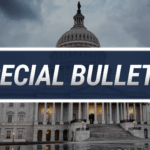Hospitals across the United States face mounting financial strain from Medicaid underpayments, but red states – those with Republican-majority legislatures and governors – stand to suffer the greatest damage if proposed federal restrictions on provider taxes and state-directed payments (SDPs) become law.
These changes, embedded in the Senate’s version of the Offsetting Budgetary Burden and Balance Act (OBBBA), threaten to unravel a critical pillar of Medicaid financing used by states to stabilize reimbursement and maintain access to care.
Massive Medicaid Underpayments
In 2023, hospitals experienced catastrophic Medicaid margins: a staggering -42 percent on inpatient obstetrics and -44.9 percent on outpatient obstetrics. Even after accounting for state-directed payments and the creative use of provider taxes to leverage federal matching funds, Medicaid still paid only 58 cents on the dollar in fee-for-service and 65 cents in managed care for each dollar hospitals spent treating Medicaid patients.
According to the American Hospital Association (AHA), this chronic underpayment translated to $27.5 billion in unreimbursed hospital costs nationwide: a burden hospitals have been expected to shoulder indefinitely.
Provider Taxes: A Lifeline for State Medicaid Programs
Provider taxes, state-imposed levies on hospitals and other healthcare providers, are used to draw down federal Medicaid matching funds. These funds are then redistributed through enhanced reimbursement or SDPs to help hospitals offset underpayments.
As the AHA underscores:
“Medicaid provider taxes are legitimate mechanisms to help states fund their programs, have been in use for decades, and are thoroughly vetted at both the state and federal levels.”
Nearly every state relies on provider taxes. According to the Kaiser Family Foundation, 49 states use provider taxes, and in many red states, these taxes fund over one-third of the state share of Medicaid spending. States such as Texas, Florida, Georgia, Mississippi, and Alabama have not expanded Medicaid under the Patient Protection and Affordable Care Act, and therefore rely more heavily on supplemental payments funded through provider taxes to ensure hospital solvency.
The Impact of Proposed Restrictions
If the OBBBA’s restrictions on provider taxes and SDPs are enacted, the Congressional Budget Office (CBO) projects devastating consequences. As the bill stands, the AHA estimates that “the provider tax changes alone will result in a loss of federal payments to hospitals of $232 billion over 10 years.”
The CBO warns that these provisions will force states to “curtail their spending by reducing provider payment rates, reducing the scope or amount of optional services, and reducing Medicaid enrollment.”
In red states, where Medicaid eligibility and benefits are already minimal, there is limited room to maneuver. These states would face untenable choices: reduce already-low Medicaid rates further, eliminate optional services like maternity care or mental health coverage, or cut provider participation entirely. This would jeopardize care for millions of low-income families, pregnant women, and children.
Red States at Higher Risk of Hospital Closure
Rural and safety-net hospitals, many of which are concentrated in red states, are especially vulnerable. The Chartis Center for Rural Health has identified over 600 rural hospitals at risk of closure, the majority in non-expansion red states. These hospitals operate on thin margins, often relying on supplemental Medicaid payments to stay open.
Without provider tax-funded SDPs, they will be unable to offset shortfalls from Medicaid underpayments.
Given the projected $232 billion cut over 10 years, if even 10 percent of that shortfall falls on rural and safety-net hospitals in red states, this could translate to $23 billion in lost payments. Based on average operating margins and cost structures, that level of reduction could result in the closure of 300 to 400 hospitals – mostly in states already facing healthcare access deserts.
States like Texas, Georgia, Mississippi, and Alabama, where Medicaid eligibility is limited and provider taxes are heavily used, are among those most at risk. The impact would ripple beyond Medicaid, affecting all patients as hospitals eliminate services, close labor and delivery units, or shut their doors altogether.
Conclusion
The proposed restrictions in the Senate’s OBBBA are not minor technical adjustments; they represent a fundamental retraction of support for Medicaid-dependent hospitals. While all states would feel the impact, red states with limited Medicaid programs and greater reliance on provider taxes are poised to suffer disproportionately. The result will not just be accounting shifts; it will be real closures, real job losses, and real lives affected.
At a time when maternal mortality is rising, rural access is declining, and health disparities are growing, this is a risk the nation – and especially its red states – cannot afford to take.
EDITOR’S NOTE:
The opinions expressed in this article are solely those of the author and do not necessarily represent the views or opinions of MedLearn Media. We provide a platform for diverse perspectives, but the content and opinions expressed herein are the author’s own. MedLearn Media does not endorse or guarantee the accuracy of the information presented. Readers are encouraged to critically evaluate the content and conduct their own research. Any actions taken based on this article are at the reader’s own discretion.






















